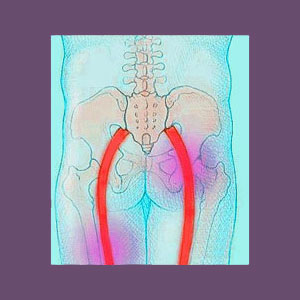
Piriformis pain sitting is a very common symptomatic exacerbating factor for many patients, since it increases pressure on the sciatic nerve. Patients who commonly sit on one side of the buttocks, rather than squarely on both sides, or those who sit with an item in their back pocket, are particularly susceptible to worsened piriformis pain while seated.
Sitting is certainly one of the most widely reported aggravators of a wide range of musculoskeletal pain syndromes, especially those affecting the lower back and hips. It is no wonder that all piriformis diagnoses are usually negatively influenced by sitting, as the activity places the full body weight on the very structures deemed to be painful. However, there are some solutions that can help patients to sit more comfortably, despite suffering from piriformis syndrome or other piriformis-related condition.
This discussion provides guidance for patients who are experiencing heightened pain when seated. We will explain why sitting exacerbates pain and what can be done to provide relief when you really must sit down for an extended period of time.
Why Does Piriformis Pain Sitting Occur?
The piriformis muscle is located in the deep buttocks, near the hip. Sitting inherently places pressure on the piriformis muscle, potentially exacerbating any painful condition that affects the tissue. Injury to the piriformis will likely produce sensitivity and direct pressure on the muscle can be painful. Muscle imbalances should not be affected by sitting, so patients who have received this diagnosis, yet do experience sitting-related pain, should definitely question the validity of their diagnostic verdict.
The most common of all piriformis-related diagnoses is certainly piriformis syndrome. In this condition, the piriformis muscle is blamed for compressing the sciatic nerve, eliciting painful pseudo-sciatica symptoms. Sitting already places pressure on the both the piriformis and the sciatic nerve, so it is no surprise that a seated posture will worsen piriformis syndrome expressions in most patients.
Seated Piriformis Pain Circumstances
Certain seated postures will likely be more painful than others. Likewise, particular circumstances of sitting might create different symptomatic circumstances:
In unilateral piriformis pain conditions, the patients can usually sit more comfortably with the weight resting more on the unaffected side of the body. While this offers a temporary solution, it can cause other problems long-term, including a higher risk of developing piriformis syndrome in the other leg. In bilateral piriformis syndrome cases, this is not even an option to consider.
Sitting is usually worse when the edge of the seat is pressuring the lower buttocks and back of the upper leg. Some patients find relief when sitting forward towards the edge of the chair and placing more weight on their legs, rather than on their buttocks.
Using the above model, patients can usually reduce pain to some degree by sitting with both feet flat on the floor, holding at least some of their weight, rather than allowing their entire mass to press down on the buttocks alone as a support base.
Driving can be particularly bad, since it tends to place the person in a compromised posture, as well as forces them to utilize their legs in this already uncomfortable position, eliminating all hope for taking some pressure off by resting some weight on the feet.
Patients should avoid sitting on uneven seating surfaces and should certainly not sit with items in their back pocket. The old urban legend about sciatica being caused by sitting with a wallet in the back pocket is actually true, since the wallet acts as a multiplier and concentrator of force and stress on the piriformis muscle and other tissues in the region.
Relief from Piriformis Pain Sitting
Trial and error in sitting techniques can produce relatively good results for some patients. If a patient can find a way to minimize direct pressure on the piriformis muscle, then sitting will become a less painful ordeal. Usually, sitting on a soft surface will assist in this process, although rarely some patients find that sitting on a firmer surface is best for their particular needs.
Certain chairs might provide relief from piriformis syndrome, particularly those that have adjustable split seat designs or those with specially-padded seating surfaces that minimize focal pressure on the muscle and sciatic nerve. There are also many piriformis cushions sold that can decrease stress on the painful muscle and nerve.
Of course, we can recommend that a certain amount of activity avoidance is also a healthy addition to any patient’s coping strategy. It is not practical to never sit, but since sitting is a known negative lifestyle factor that can lead to a sedentary lifestyle and obesity, we highly suggest alternating periods of standing and sitting whenever practical. Workers can set-up their workstations to accommodate a standing posture at their job. The benefits of this postural change can not be underestimated, as they go far beyond simple pain avoidance. Standing for half the day will burn calories, provide muscular exercise, increase metabolism and improve circulation, as well as provide additional general health benefits that transcend mere piriformis pain relief.
Piriformis Pain > Causes of Piriformis Pain > Piriformis Pain Sitting





